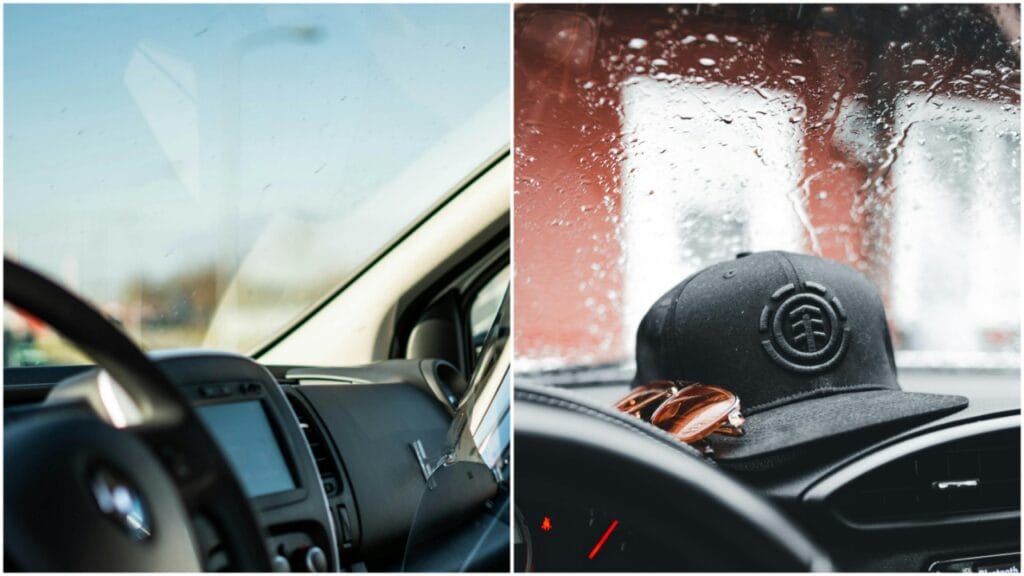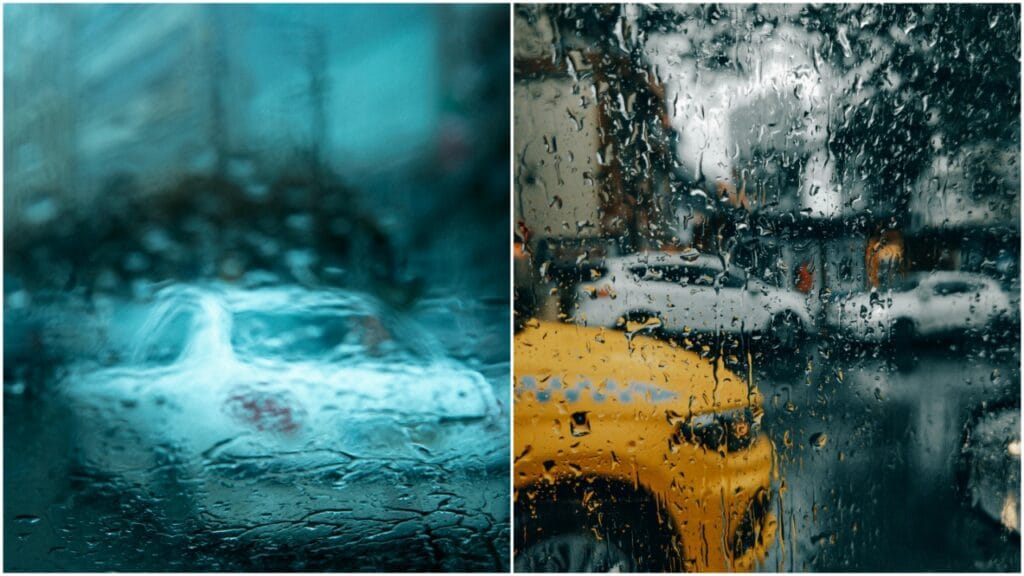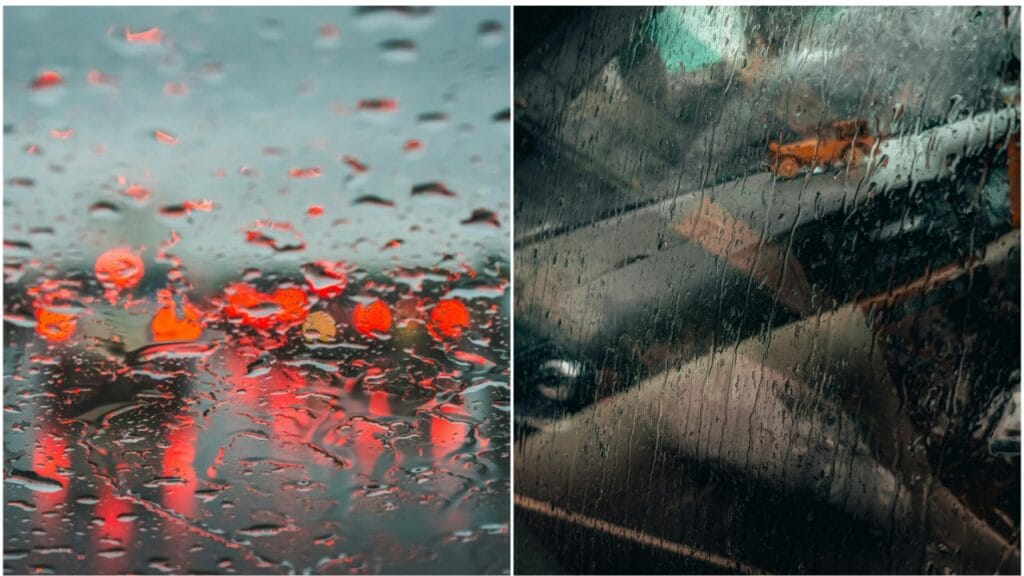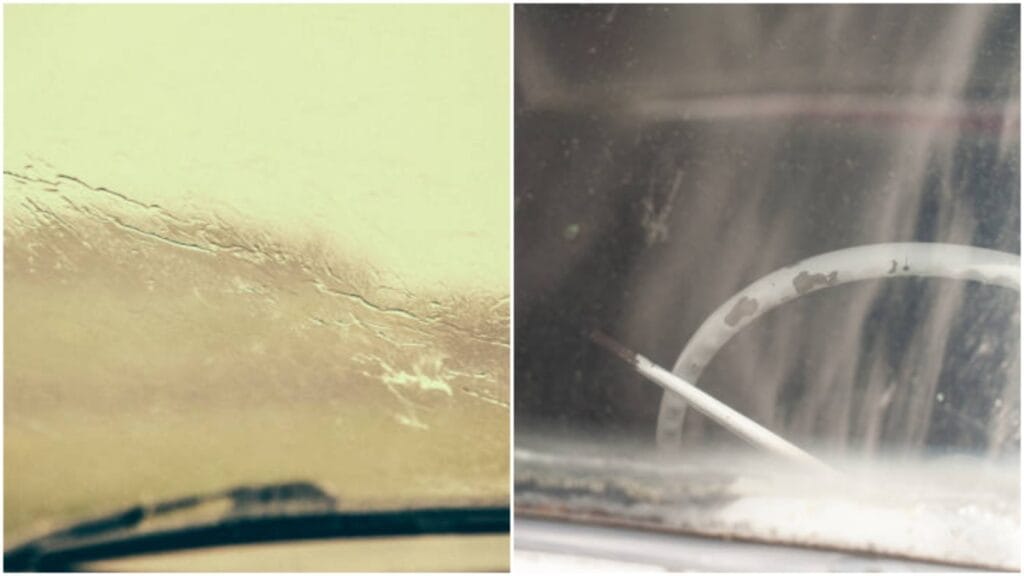An oily film on your windshield in the rain isn’t just annoying—it’s a natural hazard. To remove it, mix dish soap and warm water; the soap cuts through oils effectively. Spray or scrub the film onto the glass with a soft cloth or sponge, then rinse thoroughly.
A little rubbing alcohol can help with persistent residue. After cleaning, apply a water-repellent treatment. These products help rain bead up and roll off the glass, keeping it clear.
Keep an eye on the windshield wipers, which leave streaks if worn or dirty. Keeping your windshield crystal clear can make a big difference on rainy drives, where precise vision is everything.
What Causes the Oily Film on Your Windshield?
The world around us is a constant mess of microscopic particles—oil, dust, exhaust, pollen, grime, and the occasional squashed bug. They’re everywhere, and they love to latch onto car surfaces.
The windshield, a big sheet of glass in the direct path of wind and elements, catches it all. But when rain comes into play, these particles mix with water, creating a film. It’s like oil on water but stretched out across your line of sight.
The Danger Factor: Why This Isn’t Just an Annoyance

This oily film reduces visibility, making you feel like your wipers can’t keep up. In truth, they can’t. They’re not designed to handle oil and contaminants.
I’ve had my fair share of white-knuckle moments with a hazy windshield on a winding road.
DIY and Preventative Maintenance: Clean, Prep, Repeat
There’s no silver bullet here. But, with extra care, you can keep that windshield clear as day. This applies even on the rainiest, grimiest of drives.
The Simple Power of a Proper Clean
Think of it like a deep clean but for glass. Regular glass cleaners will only sometimes cut it because they’re made to handle bare dirt and fingerprints.
You want a degreasing cleaner that can slice through oil. When you’re cleaning, remember this: small, circular motions.
Clay Bar for That Extra Edge
Yes, clay bars aren’t just for the body of your car; they’re windshield-friendly, too. And they’re one of the best ways to strip your glass of grime you do not even know is there.
This deeper clean removes contaminants stuck in the tiny crevices of the glass. It takes a few extra minutes, but you’ll see what I mean once you’ve tried it. Smooth glass is clear glass, and clear glass is safe glass.
Rain-Repellent Solutions

You’ve heard of these. There’s a whole variety of water-repellent treatments. Rain-X and Aquapel are designed to make rainwater beads up and roll off your windshield.
These prevent it from settling into a slick film. These products do wonders. Not only do they help in the rain, but they also add a layer of protection against that oily film.
It’s like adding a tiny force field against grime. Windshield Wipers and Washer Fluid—An Overlooked Duo Believe it or not, your wipers and washer fluid matter extensively here.
Fresh wipers, especially ones designed for harsh weather conditions, make a real difference.
Do’s and Don’ts for the Long Run
Avoid using household cleaning agents on your windshield. Although tempting, these products can damage the tint or leave a residue. Stick to automotive-grade cleaners.
Please don’t overdo it with waxes or polishes. Some think a waxed windshield will keep water off, but it can worsen things.
Water beads stick instead of rolling away, especially when they mix with dirt. Regular maintenance is the real key.
Grime builds up even if you’ve cleaned, clayed, and applied rain-repellent. A quick wipe-down every few weeks helps.
The Hidden Culprits on Your Windshield

Everything from tree sap to tire particles somehow makes its way onto the glass. Then there’s the random oil mist from passing trucks, especially if you drive on highways often.
And it takes a little while for this grime to layer up. All these little things come together, turning your windshield into a blurry mess when the rain hits.
Why Fresh Rain Is the Worst
When rain starts falling, it stirs up all vehicles’ road oils and other debris. These particles mix with the rainwater, creating an oily wash that splatters onto your windshield.
This can be a huge issue, especially in places with traffic. The rain essentially becomes a carrier for grime, making visibility even worse.
The Magic of Vinegar and Water
One cheap and effective trick is a simple vinegar and water solution. The vinegar naturally cuts through oils, making it great for a deep clean.
You can make a solution with one part vinegar and two parts water. Spray it on your windshield, let it sit for a few minutes, then wipe it off with a microfiber cloth. It’s a quick fix that cuts through the muck and restores clarity.
Microfiber Cloths Over Paper Towels
Many use paper towels to wipe their windshields, but microfiber cloths are far better. They don’t just wipe; they pick up dirt and oil without scratching the glass.
Plus, they leave no lint behind, leaving you with a more transparent, streak-free surface. It’s a small switch that makes a big difference, especially for those pesky, oily spots that don’t budge.
The Unseen Problem of Interior Fog

While the exterior film is a problem, the windshield’s interior can also cause fogging. Dirt and oils from your dash slowly get trapped inside the glass over time.
This interior film fogs up when damp outside, creating another layer of visibility issues. Cleaning both sides of your windshield regularly keeps you ahead of the problem.
An anti-fog spray can also help prevent this buildup, especially in humid weather.
Keep Windshield Nozzles in Check
Washer fluid is only as adequate as the nozzles that spray it. These tiny openings can get clogged with dirt and road salt, weakening the spray and leaving your windshield streaky.
Check your nozzles every so often to ensure they’re spraying correctly. A quick clean with a needle or a blast of compressed air keeps the fluid flowing evenly, making each clean more effective.
Avoiding Parking Under Trees
It is unrelated, but where you park can make a difference. Trees drop sap, pollen, leaves, and occasionally small insects, which cling to your windshield and contribute to that dreaded oily film.
Over time, this buildup becomes more challenging to remove, especially once it’s baked on by the sun. Park in covered or clear areas. You’ll have to walk a bit farther, but it will save you from severe scrubbing later.
Keep a Routine for Best Results

Prevention works best when it’s consistent. Waiting until you can barely see through the windshield to clean it makes the job harder.
Regular cleanings, even a weekly wipe-down, keep grime from becoming a permanent fixture. Keeping glass treatments refreshed and wipers in good shape gives a clear view.
FAQ’s
Windshield wipers leave film?
Windshield wipers leaving a film can be frustrating. It’s not just an annoyance; it’s a safety issue too. The culprit is often residue on the blades or glass.
Dirt, grease, and even leftover wax from car washes can build up. Over time, wiper blades wear down. Old, cracked rubber doesn’t clean well. Instead, it smears the grime.
Cheap wipers can make it worse, as they don’t press evenly on the glass. Sometimes, the problem is in your washer fluid. Low-quality fluid or a dirty reservoir spreads more mess than it cleans.
Fixing it starts with cleaning. Use a good glass cleaner to remove grease from the windshield. Don’t forget to clean the wiper blades too. A damp cloth with rubbing alcohol works wonders.
If the film remains, check the blades. Replacing them often solves the issue. Go for quality ones; they last longer and perform better. Keeping the windshield clean helps prevent future problems.
How do you fix oily film on the windshield in the rain?
An oily film often clouds your windshield when it rains. It’s likely from road grime, wax, or residue left by car products. This film clings to the glass, making it hard for wipers to clear away water effectively.
To remove it, first deep-clean your windshield. Use an alcohol-based glass cleaner or mix vinegar and water in equal parts. Spray it on, then wipe thoroughly with a microfiber cloth.
Focus on edges where grime builds up. After cleaning, rinse and dry. For a final polish, use a clay bar, as it can lift stubborn residue stuck to the glass. Then, a hydrophobic windshield treatment will be applied to help rainwater bead and roll off quickly.
This leaves the glass clear and improves visibility when driving. Regularly changing windshield wiper blades and avoiding waxy car shampoos can prevent buildup over time.
Blurry windshield when raining!
A blurry windshield during rain often comes from residue, worn wipers, or untreated glass, making visibility challenging and driving unsafe. Dirt, oils, and car wax can build up, causing rain to smear rather than clear away.
To tackle this, start by deep cleaning the windshield using a quality glass cleaner and a microfiber cloth. For stubborn grime, use a clay bar to remove the finer debris.
After cleaning, apply a hydrophobic coating to the glass so rain beads up and rolls off easily. Check your wiper blades; old or cracked blades can worsen visibility by streaking.
Replace them every six months for the best results, especially if they skip or leave patches. Lastly, car soaps with wax for the windshield should be avoided, as they can leave a film, contributing to blurriness.
Regular maintenance like this keeps your view clear even in heavy rain, helping you drive safely.
Rain-x causes haze on the windshield?
Rain-X can sometimes cause a hazy windshield, mainly if it isn’t applied or removed correctly. The haze usually forms when leftover residue or the product isn’t fully buffed out.
This can lead to a cloudy appearance that’s particularly noticeable in wet or humid conditions. To fix it, clean the windshield with a glass cleaner to remove any oils or contaminants.
Next, use a microfiber cloth. Buff away any remaining Rain-X residue. Apply gentle but firm pressure in small circular motions. If the haze persists, try reapplying a small amount of Rain-X. Carefully buff it out again.
This will guarantee even coverage. You can also use a vinegar and water solution to help break down stubborn residue.
Proper application and regular maintenance will help prevent future haziness, leaving your windshield clear and improving visibility in rainy weather.
Oily residue on the windshield!
Oily residue on a windshield is often from road grime, car wax, or even certain cleaning products. It makes the glass hazy and difficult to see, especially in the rain.
Start by washing the windshield with an alcohol-based glass cleaner or mixing vinegar and water to clear it. Use a microfiber cloth to scrub gently, focusing on any greasy spots.
If necessary, go over the glass with a clay bar to lift stubborn residue. Finish by rinsing and drying, and consider applying a water-repellent to keep your windshield more explicit.
Conclusion
Maintaining a clear windshield is crucial for safe driving, especially in wet or foggy weather. Regular cleaning prevents the buildup of oily residue, road grime, and wax, which can create visibility issues when it rains.
Use a reliable glass cleaner to confirm your windshield stays free of streaks. If needed, apply a clay bar to remove stubborn residues and haze.
Adding a water-repellent treatment helps rain bead and roll off quickly, giving you a clear view. Simple upkeep is essential. Replace worn wiper blades.
Avoid wax-heavy cleaners. These actions go a long way in keeping your windshield clear and your driving safe.

